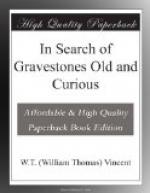Of the five old gravestones in the British Museum, four are from Ireland and one from Fardell in Devonshire. The Fardell stone was found about the year 1850, acting as a footbridge across a small brook at Fardell, near Ivybridge, Devonshire—a district once inhabited by a Celtic tribe. It is of coarse granite, 6 ft. 3 in. high, 2 ft. 9 in. broad, and from 7 to 9 inches thick. It bears an Ogam inscription on two angles of the same face, and debased Roman characters on the front and back. It reads, according to Mr. Brash, in the Ogam, “Safagguc the son of Cuic;” and, in the Roman, “Fanon the son of Rian.”
The three Irish Ogam stones were presented to the British Museum by Colonel A. Lane Fox, F.S.A., who dug them out of an ancient fort at Roovesmore, near Kilcrea, on the Cork Railway, where they were forming the roof of a subterranean chamber. No. 1 cannot be positively deciphered or translated; No. 2 is inscribed to “the son of Falaman,” who lived in the eighth century, and also to “the son of Erca,” one of a family of Kings and Bishops who flourished in the ancient kingdom of Ireland; and No. 3, which is damaged, is supposed to have been dedicated to a Bishop Usaille, about A.D. 454. All the stones came probably from some cemetery in the district in which they were found.
It has been remarked that the distribution of these old stones marks clearly the ancient history of our islands; their frequency or rarity in each case corresponding accurately with the relations existing in remote times between Ireland on the one side, and Wales, Cornwall, and Scotland on the other. Further enquiry into the subject is scarcely to be expected in this rudimentary work.
To seek for the germ of the gravestone is indeed a far quest. Like the ignis fatuus, it recedes as we seem to approach it. In the sculpture galleries of the British Museum there are several examples preserved to us from the ancient Empire of Assyria, and one described as the “Monolith of Shahnaneser II., King of Assyria, B.C. 850,” is almost the exact counterpart of the headstones which are in vogue to-day. It stands 5 ft. 6 in. high, is 2 ft. 9 in. wide, and 8 inches thick. Like the Scottish stones of the eighteenth and nineteenth centuries it is inscribed on both faces.
CHAPTER XIV.
THE REGULATION OF GRAVESTONES.
It has been already pointed out, and is probably well known, that the clergyman of the parish church has possessed from immemorial time the prerogative of refusing to allow in the churchyard under his control any monument, gravestone, design, or epitaph which is, in his opinion, irreverent, indecorous, or in any way unbecoming the solemnity and sanctity of the place. This authority, wherever exercised, has been subject to the higher jurisdiction of the Diocesan Bishop, and presumably to the rule of the Ecclesiastical Courts; but, as we have seen, the authority has been




